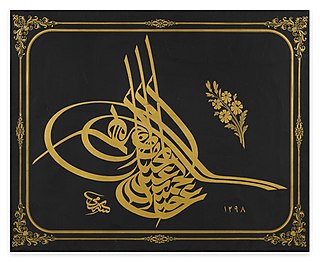
Suyolcuzade Mustafa Eyyubi (1619?, Istanbul - 1686) was a 17th-century Ottoman calligrapher.

Suyolcuzade Mustafa Eyyubi (1619?, Istanbul - 1686) was a 17th-century Ottoman calligrapher.
Suyolcuzade Mustafa Eyyubi was born in the Eyiib district of Istanbul in around 1619. He was the son of Suyolcu Ömer Ağa. [1]
Initially, he studied calligraphy with Dede, who was very elderly at the time, and known as the "grandfather". Following the master's death, Eyyubi studied with Derviş Ali. [1]
Some of his best known students are Cabizade Abdullah, Hâfiz Osman and Hocazade Mehmed. [2] [3]
Few of his works have survived. From about fifty Qur'an and 100 An'am-i Sharif written by him, just a few are available today. [4] He also produced 100 en'am and various qit'at. [5] Some of the surviving works are held in the Topkapi Collection. [6]
He died in 1686 in and was buried in the Kabristani in the Hamamarkası at Eyüp, but the location of his tomb is not known. The grave inscriptions were written by his grandson, Suyolcuzâde Mehmed Necib (d. 1757), who was also a calligrapher. [1] His grandson, Suyolcuzâde Mehmed Necib, wrote the Devḥatü l-küttāb, [translated as Genealogy of the Scribes or the Great Tree of Penmen] a compilation of biographies of famous calligraphers. [1] [7] [8] [9]
Thuluth is an Arabic script variety of Islamic calligraphy. The straight angular forms of Kufic were replaced in the new script by curved and oblique lines. In Thuluth, one-third of each letter slopes, from which the name comes. An alternative theory to the meaning is that the smallest width of the letter is one third of the widest part. It is an elegant, cursive script, used in medieval times on mosque decorations. Various calligraphic styles evolved from Thuluth through slight changes of form.

Sheikh Hamdullah (1436–1520), born in Amasya, Ottoman Empire, was a master of Islamic calligraphy.

The Sabancı University Sakıp Sabancı Museum is a private fine arts museum in Istanbul, Turkey, dedicated to calligraphic art, religious and state documents, as well as paintings of the Ottoman era. The museum was founded by Sakıp Sabancı, and was opened in June 2002. Aside from permanent exhibitions, the museum also hosts national and foreign temporary exhibitions and, hosts cultural events on the weekends.

Hâfiz Osman (1642–1698) was an Ottoman calligrapher noted for improving the script and for developing a layout template for the hilye which became the classical approach to page design.

The term hilya denotes both a visual form in Ottoman art and a religious genre of Ottoman Turkish literature, each dealing with the physical description of Muhammad. Hilya literally means "ornament".

Mustafa Râkim (1757–1826), was an Ottoman calligrapher. He extended and reformed Hâfiz Osman's style, placing greater emphasis on technical perfection, which broadened the calligraphic art to encompass the Sülüs script as well as the Nesih script.

Derviş Ali was a 17th-century Ottoman calligrapher.

Yedikuleli Seyyid Abdullah Efendi (1670-1731) was an Ottoman master calligrapher.

Egrikapili Mehmed Rasim Efendi was an Ottoman calligrapher and poet.

İsmail Zühdi Efendi was an Ottoman calligrapher. “Efendi” is a title of nobility, so this name can also be rendered İsmail Zühdi.

Mahmud Celaleddin Efendi was an Ottoman calligrapher.
Kazasker Mustafa Izzet Efendi, was an Ottoman composer, neyzen, poet and statesman best known for his calligraphy.

Mehmed Shevki Efendi was a prominent Ottoman calligrapher. He is known for his Thuluth-Naskh works, and his style developed into the Shevki Mektebi school, which many contemporary calligraphers in the style take as a reference.

Sami Efendi (1858-1912), was an Ottoman calligrapher.

Mehmed Esad Yesari was an 18th-century Ottoman calligrapher known as the greatest calligrapher of his age.

Yesarizade Mustafa Izzet Efendi was an Ottoman calligrapher.
Hamid Aytaç was an Islamic calligrapher born during Ottoman times. In his later life, he was acknowledged as the Islamic world's leading calligrapher and was one of the last of the classical calligraphers.

Mustafa Halim Özyazıcı was an Ottoman calligrapher and one of the last of the classic Ottoman calligraphers, using the Arabic script. He was a versatile calligrapher with a high level of expertise in many styles of script, but was widely regarded as a master Jeli Thuluth. He is most noted for his work on various restoration projects, of both manuscripts and public buildings.

The art of Turkish calligraphy dates back to the seventh century. The Ottoman Turks migrated from Central Asia to establish an empire in Anatolia by 1299, and conquered Constantinople in 1453. The Ottoman Empire became a major European power. After the fall of the Mamluk Sultanate (1517), the Ottomans began to exert great influence over Islamic art and placed great emphasis on calligraphy. They collaborated with Egyptian and Persian calligraphers, adopting the naskh and thuluth scripts.
![]() Media related to Suyolcuzade Mustafa Eyyubi at Wikimedia Commons
Media related to Suyolcuzade Mustafa Eyyubi at Wikimedia Commons